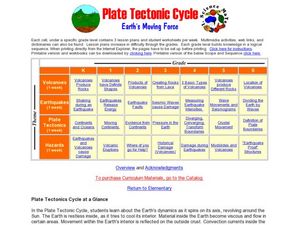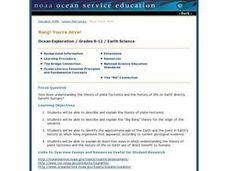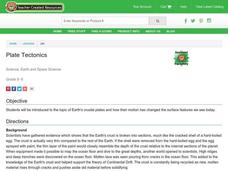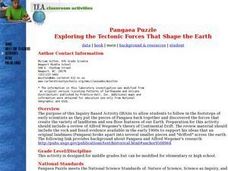Science 4 Inquiry
Edible Plate Tectonics
Many people think they can't observe plate tectonics, but thanks to GPS, we know that Australia moves at a rate of 2.7 inches per year, North America at 1 inches per year, and the Pacific plate at more than 3 inches per year! Scholars...
Curated OER
Fossil Evidence for Plate Tectonics
Students draw maps of counties that were important to the discovery of plate tectonic theory. In this plate tectonics lesson students excavate constructed fossil sites from matching coastlines and discuss the possible explanations for...
Curated OER
Floating Plates on the Earth
Fourth graders construct a concept map about Plate Tectonics. They include types of movement, names and effects of boundaries. They research plate tectonics, describe and name 3 types. They analyze the effect on the earth's surface of...
Curated OER
Plate Tectonic Cycle
Learners explore the Earth's movements by completing worksheets. In this plate tectonics instructional activity, students define such natural disasters as volcanoes, earthquakes, tsunamis and mudslides and discuss their connections to...
Curated OER
Plate Tectonics
Students watch a video about plate tectonics. in this Earth Science lesson, students watch a video clip from Bill Nye about Continental Drift and Plate Tectonics. They make a slight crack in a hard boiled egg and manipulate the egg to...
Curated OER
Earthquakes and Plate Tectonics
Students research about earthquakes that took place within a certain distance from their place. In this geology lesson, students explain why earthquakes occur. They analyze patterns of different earthquakes using a computer program.
Channel Islands Film
Island Rotation: Lesson Plan 1
How do scientists provide evidence to support the theories they put forth? What clues do they put together to create these theories? After watching West of the West's documentary Island Rotation class members engage in a series of...
Channel Islands Film
Island Rotation: Lesson Plan 3
How far have California's Channel islands moved? What was the rate of this movement? Class members first examine data that shows the age of the Hawaiian island chain and the average speed of the Pacific Plate. They then watch West of the...
Curated OER
Plate Tectonics Boundaries
Students discover how to create a model of tectonic plates and study the interactions of these plates as they slowly move on the asthenosphere. They see and experience what happens at each type of plate boundary and why there are certain...
Curated OER
Plate Tectonics Day 3 Sea Floor Spreading: Evidence for Continental Drift
Students are introduced to Sea Floor Spreading and how it provides evidence for Hess's and Deitz's theory of Continental Drift. They use paleomagnetic data to calculate the rate of Sea Floor Spreading.
Curated OER
Bang! You're Alive
Students explore the Big Bang Theory and the Theory of Plate Tectonics. In this history of life lesson, students explain two ways the Theory of Plate Tectonics and the Big Bang are of direct benefits to humans.
Curated OER
Earth Forces
High schoolers use geological techniques such as plate tectonics, mountain building, earthquakes, and volcanoes, in order to explain the earth.
Curated OER
Our Changing View of the Earth
Students explore the theory of Plate Tectonics. They participate in a simulation in which they re-enact the debate over Plate Tectonics vs. traditional beliefs of stationary continents that were widely accepted during the 1800's and...
Curated OER
Plate Tectonics
Students complete a data sheet. In this Earth composition lesson, students learn what happens when the Earth's plates push against each other. They watch a teacher demonstration and complete a data sheet.
Curated OER
Day 4: Plate Tectonics II
Young scholars explore the theory of plate tectonics. In this geology lesson, students conduct a simulation of the crust of the Earth floating on the mantle. Young scholars research plate tectonics and share their findings with the...
Curated OER
Science: Plate Tectonics, Faults, and Volcanoes
Eighth graders conduct Internet research on plate tectonics, faluts, and volcanoes. In groups, they compile information related to teacher-provided questions. Students write papers detailing their findings and make oral presentations...
Curated OER
Pangaea Puzzle: Exploring the Tectonic Forces That Shape the Earth
Sixth graders follow in the footsteps of early scientists as they put the pieces of Pangaea back together and discovered the forces that create the variety of landforms and sea-floor features of our Earth.
Curated OER
Earthquakes And Fault Lines
Students discuss major causes of earthquakes and identify famous fault lines, access and map information about ten largest earthquakes in world from 1989 to 1998, and theorize about location of these earthquakes as they relate to Earth's...
Curated OER
Earthquakes And Volcanoes
Pupils investigate the concept of plate tectonics through focusing a research study upon the occurrence of earthquakes and volcanic eruptions. They find information that is used for class discussion. Students complete a mapping of plates...
Curated OER
Tectonic Plates, Earthquakes, and Volcanoes
Challenge geography classes to locate the major volcanoes and earthquake faults on a world map. In groups, they identify the pattern made and examine the relationship between the locations of the faults and volcanoes and tectonic plates....
Channel Islands Film
Island Rotation: Lesson Plan 2
Why are Torrey pines only found in La Jolla, California and on Santa Rosa Island? Class members examine images of Torrey pines from these two locations, noting the similarities and differences, and then develop a demonstration model that...
Curated OER
Prehistoric Mesosaurus
Learners draw conclusions why Mesosaurus has only been found in Africa and Brazil and how its fossil remains serve as important evidence that shows where two continents were once joined together.
Curated OER
Lesson 2: Look for Patterns
Students compare map they created in Lesson 1 to map showing tectonic plates and look for a relationship.
PBS
Earth’s Ever-Changing Surface
The Grand Canyon formed between five and six million years ago, but is it still changing? Scholars explore 10 sites in the United States, including the Grand Canyon, to better understand the geoscience processes that formed these...

























